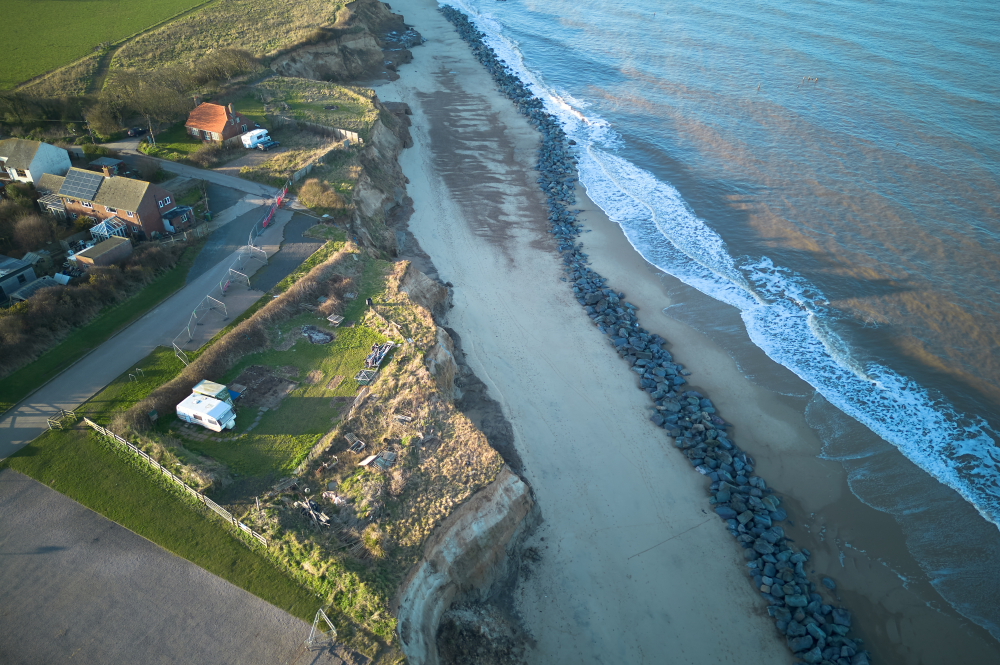Are UK Coastlines in Danger?

With summer in full swing, thousands of holidaymakers will flock to UK beaches in the next few months, but are our coastlines in danger due to climate change?
The Connection Between Coastlines and Climate Change
Although coastlines naturally change over time, climate change is accelerating the pace of change. Coastal erosion is a natural process involving the movement and loss of soil, sand, and bedrock, leading to the erosion of cliffs, rocks, dunes, and beaches. This, in turn, can make the ground unstable and can even lead to landslides. By 2100, the Met Office predicts that sea levels may rise around the nation by over a metre in many locations.
Causes of Coastal Erosion
Longshore Drift
Longshore Drift is the process by which sediment and material are moved along the coastline by waves at a right angle, in a zig-zag pattern. This shapes the coastline by removing material and depositing it elsewhere down the coast. Climate change influences wave patterns and storm intensity, impacting how sediment is transported.
Melting Ice Caps
Thermal expansion, where water expands due to a rise in temperature, in addition to melting glaciers and ice caps, is leading to sea levels rising. This in turn can lead to coastal flooding, damaging sea beds and shorelines, with waves being able to extend further along beaches and cliffs. Over the next few centuries, melting ice could mean that sea levels rise by several metres or more.
Storms
As previously discussed, climate change is escalating the threat of natural disasters, including storms that pose a risk to coastlines. Elevated storm surges and wave heights, caused by stronger winds and higher tides, are leading to increased coastal erosion.
Human Activity
Humans are also responsible for the damage to coastlines. With more and more tourists visiting seaside locations of the UK, the increasing influx of visitors contributes to the degradation of coasts and their ecosystems. Additionally, sand dunes—natural barriers to protect against storm surges and high tides—are becoming increasingly damaged, with footpaths becoming channels for wind and water, accelerating erosion.
Case Studies
The east coast of England has soft sediment and low-lying coastlines, making it more vulnerable to erosion. Specifically, Happisburgh in Norfolk is already experiencing significant coastal erosion and loss of homes, with over 30 homes falling into the sea in the last two decades.1 As the cliffs are made from boulder clay, they slump when wet, giving them less protection against powerful waves.
Meanwhile, on the other side of the country, Fairbourne in Wales is another area that is experiencing the worsening effects of erosion, with shoreline management plans stating that it will not be safe or sustainable for villagers to remain by 2054.
Impacts
Economic Impacts
It is not just cliff edges and coasts that are lost to the sea, but also infrastructure, businesses and homes. Additionally, erosion may result in the loss of sites of historical importance, including settlements and significant landmarks. This loss represents an irreplaceable gap in the understanding of our history and the development of these coastlines.
Land Migration
It is estimated that over 8,000 properties in England are at risk of being lost due to coastal erosion and flooding.2 This may cause vast numbers of people to abandon villages and move inland, resulting in displaced communities, and loss of livelihoods and cultural identity. In addition, it puts a strain on inner towns and cities, increasing demand for housing and infrastructure.
Natural Coastal Erosion
Regardless of climate change, coastal erosion is a natural process and is important for nature. It allows eroded sediment to move, generating habitats for sea life and creating natural protection such as beaches, dunes and shingle ridges. However, it is being accelerated by human activities, leading to irreparable damage.
Fighting Coastal Erosion
Coastal erosion rates are shaped by an area’s geology and natural processes. While periods of minimal or no erosion can occur unpredictably, the effects of climate change on coastlines are now too advanced to stop. Therefore, proactive planning and management of these changes are essential, including the protection of wildlife and other vulnerable elements.
To combat erosion, various government schemes and coastal defences can be implemented, including the construction of sea walls to manage flooding and prevent natural erosion, beach nourishment to replenish lost material, and the enhancement of shingle beaches to boost coastal resilience. Additionally, sand dune regeneration offers a natural defence against coastal flooding and can reduce waves before they reach the shore.
To effectively prepare for and adapt to a changing climate, it is crucial to understand present and future risks posed by floods and coastal erosion.
1 BBC
2 Cameron


